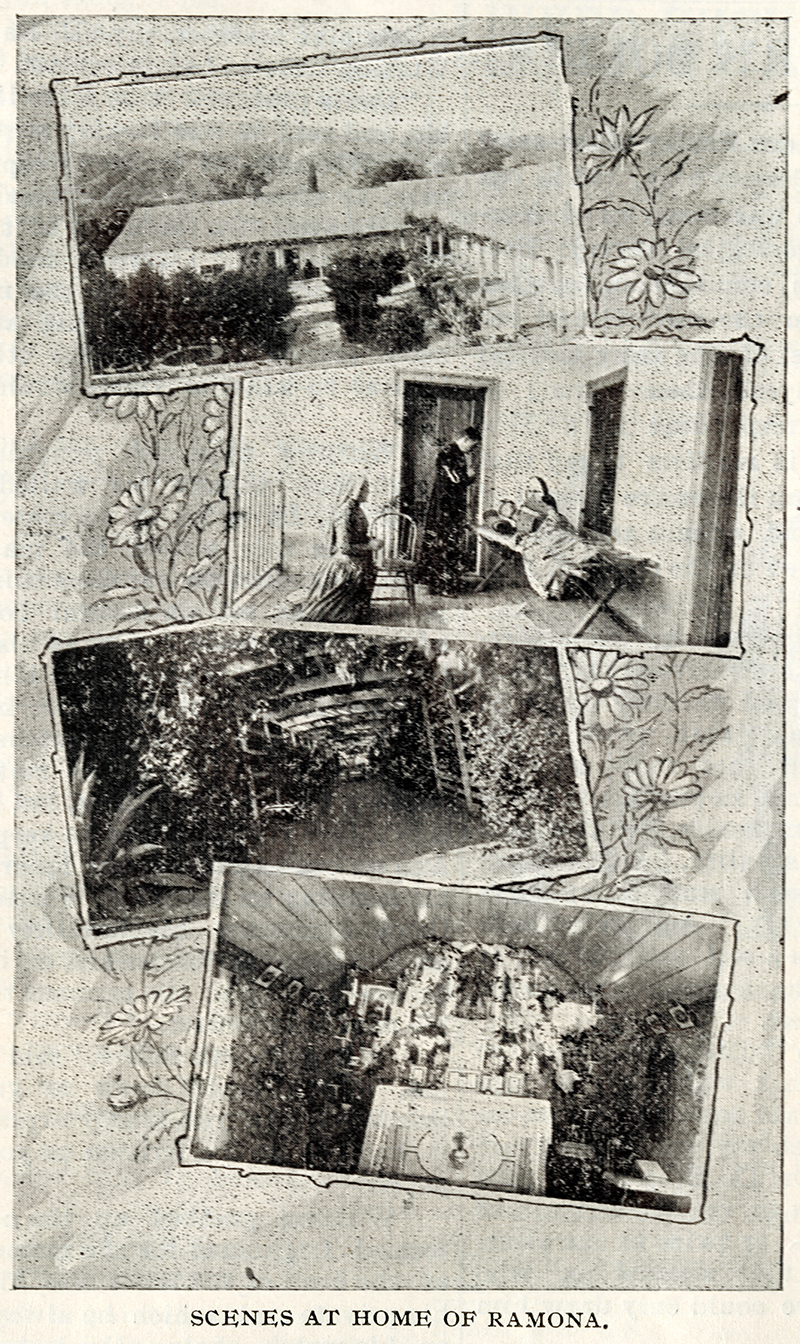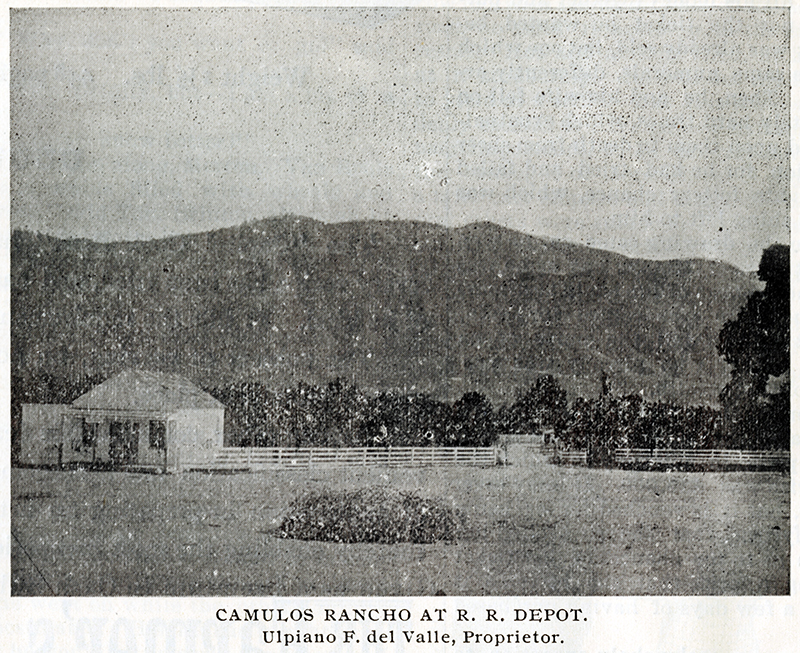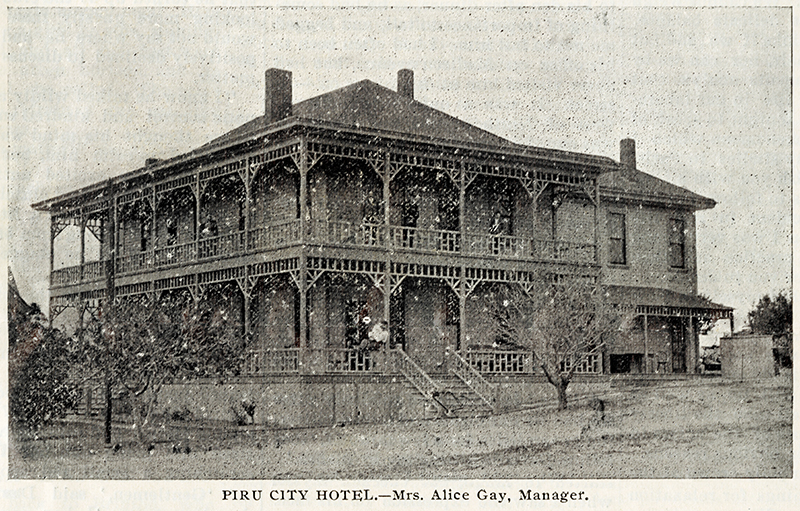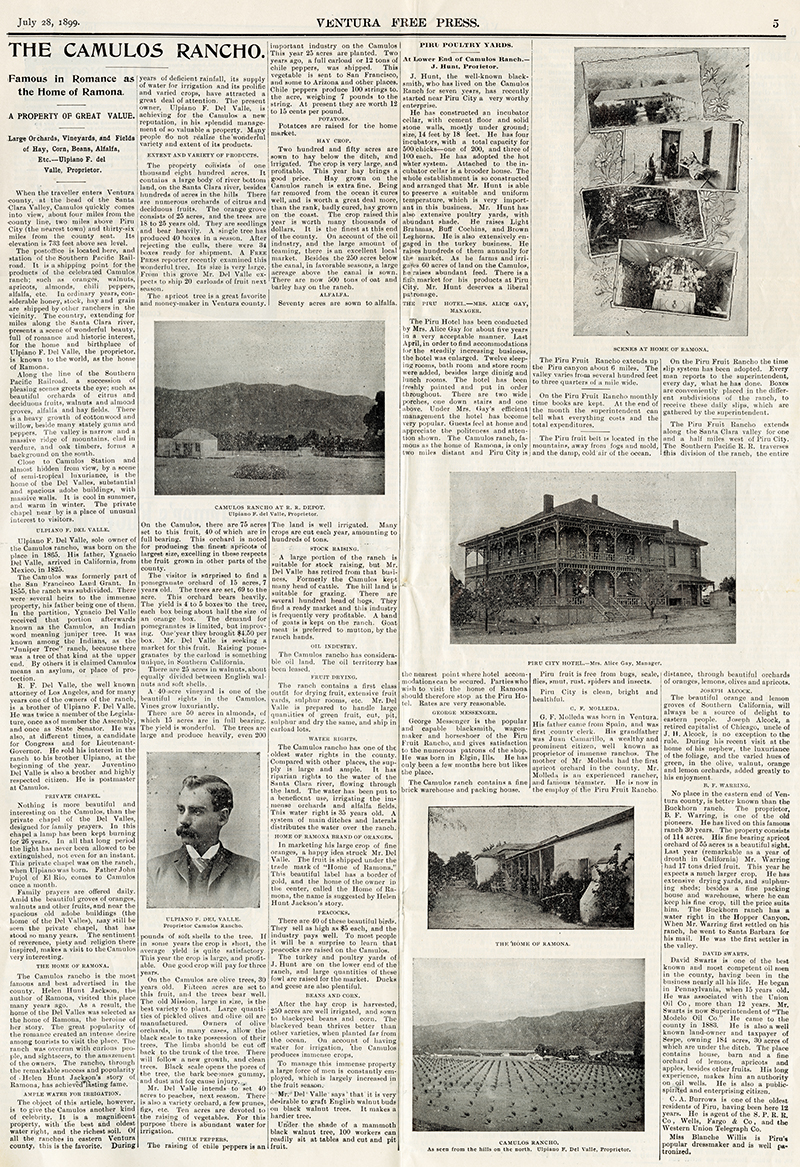
Click to enlarge.
|
A Property of Great Value.
Large Orchards, Vineyards, and Fields of Hay, Corn, Beans, Alfalfa, Etc. — Ulpiano F. del Valle, Proprietor.
When the traveller enters Ventura county, at the head of the Santa Clara Valley, Camulos quickly comes into view, about four miles from the county line, two miles above Piru City (the nearest town) and thirty-six miles from the county seat. Its elevation is 733 feet above sea level.
The postoftice is located here, and station of the Southern Pacific Railroad. It is a shipping point for the products of the celebrated Camulos ranch; such as oranges, walnuts, apricots, almonds, chili peppers, alfalfa, etc. In ordinary years, considerable honey, stock, hay and grain are shipped by other ranchers in the vicinity. The country, extending for miles along the Santa Clara river, presents a scene of wonderful beauty, full of romance and historic interest, for the home and birthplace of Ulpiano F. Del Valle, the proprietor, is known to the world, as the home of Ramona.
Along the line of the Southern Pacific Railroad, a succession of pleasing scenes greets the eye; such as beautiful orchards of citrus and deciduous fruits, walnuts and almond groves, alfalfa and hay fields. There is a heavy growth of cottonwood and willow, beside many stately gums and peppers. The valley is narrow and a massive ridge of mountains, clad in verdure, and oak timbers, forms a background on the south,
Close to Camulos Station and almost hidden from view, by a scene of semi-tropical luxuriance, is the home of the Del Valles, substantial and spacious adobe buildings, with massive walls. It is cool in summer, and warm in winter. The private chapel near by is a place of unusual interest to visitors.
Ulpiano F.DPel Valle, sole owner of the Camulos rancho, was born on the place in 1865. His father, Ygnacio Del Valle, arrived in California, from Mexico, in 1825.
The Camulos was formerly part of the San Francisco Land Grant. In 1855, the ranch was subdivided. There were several heirs to the immense property, his father being one of them. In the partition, Ygnacio Del Valle received that portion afterwards known as the Camulos, an Indian word meaning juniper tree. It was known among the Indians as the "Juniper Tree" ranch, because there was a tree of that kind at the upper end. By others it is claimed Camulos means an asylum, or place of protection.
R.F. [Reginado] Del Valle, the well known attorney of Los Angeles, and for many years one of the owners of the ranch, is a brother of Ulpiano F. Del Valle. He was twice a member of the Legislature, once as of member the Assembly, and once as State Senator. He was also, at different times, a candidate for Congress and for Lieutenant-Governor. He sold his interest in the ranch to his brother Ulpiano at the beginning of the year. Juventino Del Valle is also a brother and highly respected citizen. He is postmaster at Camulos.
Nothing is more beautiful and interesting on the Camulos than the private chapel of the Del Valles, designed for family prayers. In this chapel a lamp has been kept burning for 26 years. In all that long period the light has never been allowed to be extinguished, not even for an instant. This private chapel was on the ranch when Ulpiano was born. Father John Pujol of El Rio comes to Camulos once a month.
Family prayers are offered daily. Amid the beautiful groves of oranges, walnuts and other fruits, and near the spacious old adobe buildings (the home of the Del Valles), may still be seen the private chapel that has stood so many years. The sentiment of reverence, piety and religion there inspired, makes a visit to the Camulos very interesting.
The Camulos rancho is the most famous and best advertised in the county. Helen Hunt Jackson, the author of Ramona, visited this place many years ago. As a result, the home of the Del Valles was selected [sic] as the home of Ramona, the heroine of her story. The great popularity of the romance created an intense desire among tourists to visit the place. The ranch was overrun with curious people and sightseers, to the amazement of the owners. The rancho, through the remarkable success and popularity of Helen Hunt Jackson's story of Ramona, has achieved lasting fame.
Ample Water for Irrigation.
The object of this article, however, is to give the Camulos another kind of celebrity. It is a magnificent property, with the best and oldest water right, and the richest soil. Of all the ranches in eastern Ventura county, this is the favorite. During years of deficient rainfall, its supply of water for irrigation and its prolific and varied crops, have attracted a great deal of attention. The pressent owner, Ulpiano F. Del Valle, is achieving for the Camulos a new reputation in his splendid management of so valuable a property. Many people do not realize the wonderful variety and extent of its products.

Click to enlarge.
|
Extent and Variety of Products.
The property consists of one thousand eight hundred acres. It contains a large body of river bottom land on the Santa Clara river, besides hundreds of acres in the hills. There are numerous orchards of citrus and deciduous fruits. The orange grove consists of 25 acres, and the trees are 18 to 25 years old. They are seedlings and bear heavily. A single tree has produced 40 boxes in a season. After rejecting the culls, there were 34 boxes ready for shipment. A Free Press reporter recently examined this wonderful tree. Its size is very large. From this grove Mr. Del Valle expects to ship 20 carloads of fruit next season.
The apricot tree is a great favorite and money-maker in Ventura county. On the Camulos, there are 75 acres set to this fruit, 40 of which are in full bearing. This orchard is noted for producing the finest apricots of largest size, excelling in these respects the fruit grown in other parts of the county.
The visitor is surprised to find a pomegranate orchard of 15 acres, 7 years old. The trees are set 69 to the acre. This orchard bears heavily. The yield is 4 to 5 boxes to the tree, each box being about half the size of an orange box. The demand for pomegranates is limited, but improving. One year they brought $4.50 per box. Mr. Del Valle is seeking a market for this fruit. Raising pomegranates by the carload is something unique in Southern California.
There are 25 acres in walnuts, about equally divided between English walnuts and soft shells.
A 40-acre vineyard is one of the beautiful sights in the Camulos. Vines grow luxuriantly.
There are 50 acres in almonds, of which 15 acres are in full bearing. The yield is wonderful. The trees are large and produce heavily, even 200 pounds of soft shells to the tree. If in some years the crop is short, the average yield is quite satisfactory. This year the crop is large and profitable. One good crop will pay for three years.
On the Camulos are olive trees, 30 years old. Fifteen acres are set to this fruit, and the trees bear well. The old Mission, large in size, is the best variety to plant. Large quantities of pickled olives and olive oil are manufactured. Owners of olive orchards, in many cases, allow the black scale to take possession of their trees. The limbs should be cut off back to the trunk of the tree. There will follow a new growth, and clean trees. Black scale opens the pores of the tree, the bark becomes gummy, and dust and fog cause injury.
Mr. Del Valle intends to set 40 acres to peaches, next season. There is also a variety orchard, a few prunes, figs, etc. Ten acres are devoted to the raising of vegetables. For this purpose there is abundant water for irrigation.
The raising of chile peppers is an important industry on the Camulos. This year 25 acres are planted. Two years ago, a full carload or 12 tons of chile peppers was shipped. This vegetable is sent to San Francisco, and some to Arizona and other places. Chile peppers produce 100 strings to the acre, weighing 7 pounds to the string. At present they are worth 12 to 15 cents per pound.
Potatoes are raised for the home market.
Two hundred and fifty acres are sown to hay below the ditch, and irrigated. The crop is very large, and profitable. This year hay brings a good price. Hay grown on the Camulos ranch is extra fine. Being far removed from the ocean it cures well, and is worth a great deal more than the rank, badly cured hay grown on the coast. The crop raised this year is worth many thousands of dollars. It is the finest at this end of the county. On account of the oil industry and the large amount of teaming, there is an excellent local market. Besides the 250 acres below the canal, in favorable seasons, a large acreage above the canal is sown. There are now 500 tons of oat and barley hay on the ranch.
Seventy acres are sown to alfalfa. The land is well irrigated. Many crops are cut each year, amounting to hundreds of tons.
A large portion of the ranch is suitable for stock raising, but Mr. Del Valle has retired from that business. Formerly the Camulos kept many head of cattle. The hill land is suitable for grazing. There are several hundred head of hogs. They find a ready market, and this industry is frequently very profitable. A band of goats is kept on the ranch. Goat meat is preferred to mutton, by the ranch hands.
The Camulos rancho has considerable oil land. The oil territory has been leased.
The ranch contains a first-class outfit for drying fruit, extensive fruit yards, sulphur rooms, etc. Mr. Del Valle is prepared to handle large quantities of green fruit, cut, pit, sulphur and dry the same, and ship in carload lots.
The Camulos rancho has one of the oldest water rights in the county. Compared with other places, the supply is large and ample. It has riparian rights to the water of the Santa Clara river, flowing through the land. The water has been put to beneficient use, irrigating the immense orchards and alfalfa fields. This water right is 35 years old. A system of main ditches and laterals distributes the water over the ranch.
Home of Ramona Brand of Oranges.
In marketing his large crop of fine oranges, a happy idea struck Mr. Del Valle. The fruit is shipped under the trade mark of "Home of Ramona." This beautiful label has a border of gold, and the home of the owner in the center, called the Home of Ramona, the name is suggested by Helen Hunt Jackson's story.
There are 40 of these beautiful birds. They sell as high as $5 each, and the industry pays well. To most people it will be a surprise to learn that peacocks are raised on the Camulos.
The turkey and poultry yards of J. Hunt are on the lower end of the ranch, and large quantities of these fowl are raised for the market. Ducks and geese are also plentiful.
After the hay crop is harvested, 250 acres are well irrigated, and sown to blackeyed beans and corn. The blackeyed bean thrives better than other varieties, when planted far from the ocean. On account of having water for irrigation, the Camulos produces immense crops.
To manage this immense property a large force of men is constantly employed, which is largely increased in the fruit season.
Mr. Del Valle says that it is very desirable to graft English walnut buds on black walnut trees. It makes a hardier tree.
Under the shade of a mammoth black walnut tree, 100 workers can readily sit at tables and cut and pit fruit.

At Lower End of Camulos Ranch. — J. Hunt, Proprietor.
J. Hunt, the well-known blacksmith, who has lived on the Camulos Ranch for seven years, has recently started near Piru City a very worthy enterprise.
He has constructed an incubator cellar, with cement floor and solid stone walls, mostly under ground; size, 14 feet by 18 feet. He has four incubators, with a total capacity for 500 chicks — one of 200, and three of 100 each. He has adopted the hot water system. Attached to the incubator cellar is a brooder house. The whole establishment is so constructed and arranged that Mr. Hunt is able to preserve a suitable and uniform temperature, which is very important in this business. Mr. Hunt has also extensive poultry yards, with abundant shade. He raises Light Brahmas, Buff Cochins, and Brown Leghorns. He is also extensively engaged in the turkey business. He raises hundreds of them annually for the market. As he farms and irrigates 60 acres of land on the Camulos, he raises abundant feed. There is a fine market for his products at Piru City. Mr. Hunt deserves a liberal patronage.

Click to enlarge.
|
The Piru Hotel. — Mrs. Alice Gay, Manager.
The Piru Hotel has been conducted by Mrs. Alice Gay for about five years in a very acceptable matter. Last April, in order to find accommodations for the steadily increasing business, the hotel was enlarged. Twelve sleeping rooms, bath room and store room were added, besides large dining and lunch rooms. The hotel has been freshly painted and put in order throughout. There are two wide porches, one down stairs and one above. Under Mrs. Gay's efficient management the hotel has become very popular. Guests feel at home and appreciate the politeness and attention shown. The Camulos ranch, famous as the home of Ramona, is only two miles distant and Piru City is the nearest point where hotel accommodations can be secured. Parties who wish to visit the home of Ramona should therefore stop at the Piru Hotel. Rates are very reasonable.
George Messenger is the popular and capable blacksmith, wagon-maker and horseshoer of the Piru Fruit Rancho, and gives satisfaction to the numerous patrons of the shop. He was born in Elgin, Ill. He has only been a few months here but likes the place.
* * *
The Camulos ranch contains a fine brick warehouse and packing house.
* * *
The Piru Fruit Rancho extends up the Piru canyon about 6 miles. The valley varies from several hundred feet to three quarters of a mile wide.
* * *
On the Piru Fruit Rancho monthly time books are kept. At the end of the month the superintendent can tell what everything costs and the total expenditures.
* * *
The Piru fruit belt is located in the mountains, away from fogs and mold and the damp, cold air of the ocean.
Piru fruit is free from bugs, scale, flies, smut, rust, spiders and insects.
Piru City is clean, bright and beautiful.
G.F. Molleda was born in Ventura. His father came from Spain and was first county clerk. His grandfather was Juan Camarillo, a wealthy and prominent citizen, well known as proprietor of immense ranchos. The mother of Mr. Molleda had the first apricot orchard in the county. Mr. Molleda is an experienced rancher and famous teamster. He is now in the employ of the Piru Fruit Rancho.
* * *
On the Piru Fruit Rancho the time slip system has been adopted. Every man reports to the superintendent, every day, what he has done. Boxes are conveniently placed in the different subdivisions of the ranch, to receive these daily slips, which are gathered by the superintendent.
* * *
The Piru Fruit Rancho extends along the Santa Clara valley for one and a half miles west of Piru City. The Southern Pacific R.R. traverses this division of the ranch, the entire distance, through beautiful orchards of oranges, lemons, olives and apricots.
The beautiful orange and lemon groves of Southern California will always be a source of delight to eastern people. Joseph Alcock, a retired capitalist of Chicago, uncle of J.H. Alcock, is no exception to the rule. During his recent visit at the home of his nephew, the luxuriance of the foliage, and the varied hues of green, in the olive, walnut, orange and lemon orchards, added greatly to his enjoyment.
No place in the eastern end of Ventura county is better known than the Buckhorn ranch. The proprietor, B.F. Warring, is one of the old pioneers. He has lived on this famous ranch 30 years. The property consists of 114 acres. His fine bearing apricot orchard of 55 acres is a beautiful sight. Last year (remarkable as a year of drouth in California), Mr. Warring had 17 tons dried fruit. This year he expects a much larger crop. He has extensive drying yards, and sulphuring sheds; besides a fine packing house and warehouse where he can keep his find crop till the price suits him. The Buckhorn ranch has a water right in the Hopper Canyon. When Mr. Warring first settled on his ranch, he went to Santa Barbara for his mail. He was the first settler in the valley.
David Swarts is one of the best-known and most competent oil men in the county, having been in the business nearly all bis life. He began in Pennsylvania, when 15 years old. He was associated with the Union Oil Co., more than 12 years. Mr. Swarts is now superintendent of "The Modelo Oil Co." He came to the county in 1883. He is also a well-known land owner and taxpayer of Sespe, owning 184 acres, 30 acres of which are under the ditch. The place contains house, barn and a fine orchard of lemons, apricots and apples, besides other fruits. His long experience makes him an authority on oil wells. He is also a public-spirited and enterprising citizen.
* * *
C.A. Burrows is one of the oldest residents of Piru, having been here 12 years. He is agent of the S.P.R.R. Co., Wells, Fargo & Co, and the Western Union Telegraph Co.
* * *
Miss Blanche Willis is Piru's popular dressmaker and is well patronized.

Right-click image to download original scan.














